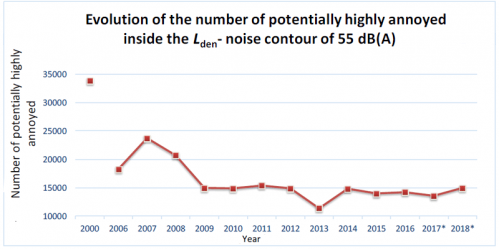Noise Contours around Brussels Airport for the Year 2018
Brussels Airport permanently carries out noise measurements to map the noise pollution around the airport. You can view these measurements here. In addition, the airport also has noise contours calculated every year. These calculations are carried out by an independent body; since 2015, this has been Ghent University. The full report for 2018 can also be found here.
The noise contour report for 2018 shows that the number of people potentially highly inconvenienced by noise pollution rose from 13,575 in 2017 to 14,948 in 2018. When we compare the figures for the past 20 years, we see that this number has decreased significantly compared to 2000, despite the fact that the number of passengers transported was lower at that time.
If we only compare the figures with those of the last 10 years, we see the number of people potentially severely inconvenienced by noise pollution has remained more or less constant during that period, around 15,000 persons. In that same period, the number of passengers travelling via Brussels Airport has increased by more than 50%.

The aircraft fleet, runway use and the number of (night) movements have the greatest influence on the noise contours.
The fleet of aircraft has had a positive influence on noise contours for years. Thanks to the policy of levying airport charges in order to encourage more modern aircraft to use Brussels Airport, the airport welcomed more low-noise aircraft in 2018 than in the previous year. And yet the noise contours have increased in comparison with 2017.
The main reason for this is the relatively frequent occurrence of wind from the east during 2018. As a result, approximately 20% of the movements had to deviate from the preferential runway use scheme ( PRS ) and there was therefore more alternative runway use. In 2017, this only occurred in 10% of the cases.
Another cause is in the evolution of the number of flight movements. Although the total number of movements decreased by around 1% in 2018, there was a slight increase in air traffic during the evening period (7.00 pm to 11.00 pm) and the night period (11.00 pm to 7.00 am). Many flights with a day slot took off or landed in the night, because there were, particularly in the summer, capacity problems in the European airspace. For example, there were strikes by air traffic controllers in France, which meant that aircraft from Spain had to fly around France instead of over it. As a result, aircraft were in the air longer and thus landed later in Brussels.
Finally, the number of people living around the airport also increased by 1.3%. If the noise contours had been exactly the same as those in 2017, the number of people potentially severely inconvenienced by noise pollution would also have increased, namely with 1.3% due to the population increase within the contours.
Related articles
Brussels Airport publishes 2024 noise contour report
Brussels Airport has the noise impact around the airport mapped every year. The report for 2024 is now available.
Clearer information about maintenance works thanks to updated webpage
Maintenance works on the tarmac at Brussels Airport are announced on this website in the "works" section. From 28 April 2025, an updated page will provide a clearer and more detailed overview of the works and their impact on runway usage at the airport.
Brussels Airport and skeyes begin demonstration flights with steeper and innovative approach trajectories
Brussels Airport and air navigation service provider (ANSP) skeyes will commence demonstration flights as part of the HERON project from 1st October. The aim of these flights is to assess whether landings with a steeper approach than usual could offer benefits in terms of reducing noise impact for surrounding communities, as well as lowering CO2 emissions and fuel consumption.